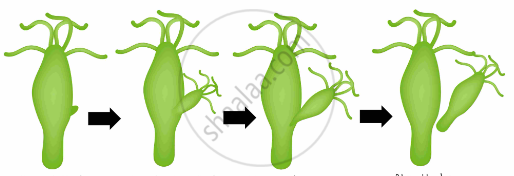Advertisements
Advertisements
Question
Explain with the help of a labelled diagram, the process of reproduction in Hydra by budding. Name the cells used for reproduction in this process.
Solution
Organisms such as Hydra use regenerative cells for reproduction in the process of budding. In Hydra, a bud develops as an outgrowth due to repeated cell division at one specific site. These buds develop into tiny individuals and when fully mature, detach from the parent body and become new independent individuals.

APPEARS IN
RELATED QUESTIONS
Label the parts (1) and (2) in budding of yeast cell.

What is the name of asexual reproduction method in Spirogyra
Name two organisms which reproduce by the same asexual process as that of Amoeba.
Multiple fission occurs in one of the following. This is :
(a) bread mould
(b) kala-azar parasite
(c) flatworm
(d) malaria parasite
A filamentous alga X is found in ponds, lakes and slow-moving streams. The filament of this alga simply breaks into two (or more) pieces on maturing and each piece then grows to become a complete new alga.
(a) Name an alga which X is likely to be.
(b) What is the colour of X?
(c) What is the method of forming new algae by the breaking of parent alga known as?
(d) An Amoeba also breaks up to form two daughter Amoebae. What is the difference in the splitting of Amoeba and splitting of this alga as a method of reproduction?
(e) Name one marine animal which reproduces in the same way as alga X.
List in tabular form two differences between binary fission and multiple fission.
How is plant hybridisation as a technique beneficial?
Asexual reproduction occurs by __________ cell division.
In Rhizopus, tubular thread-like structures bearing sporangia at their tips are called
Which of the following statements are true for flowers?
- Flowers are always bisexual
- They are the sexual reproductive organs
- They are produced in all groups of plants
- After fertilisation they give rise to fruits
